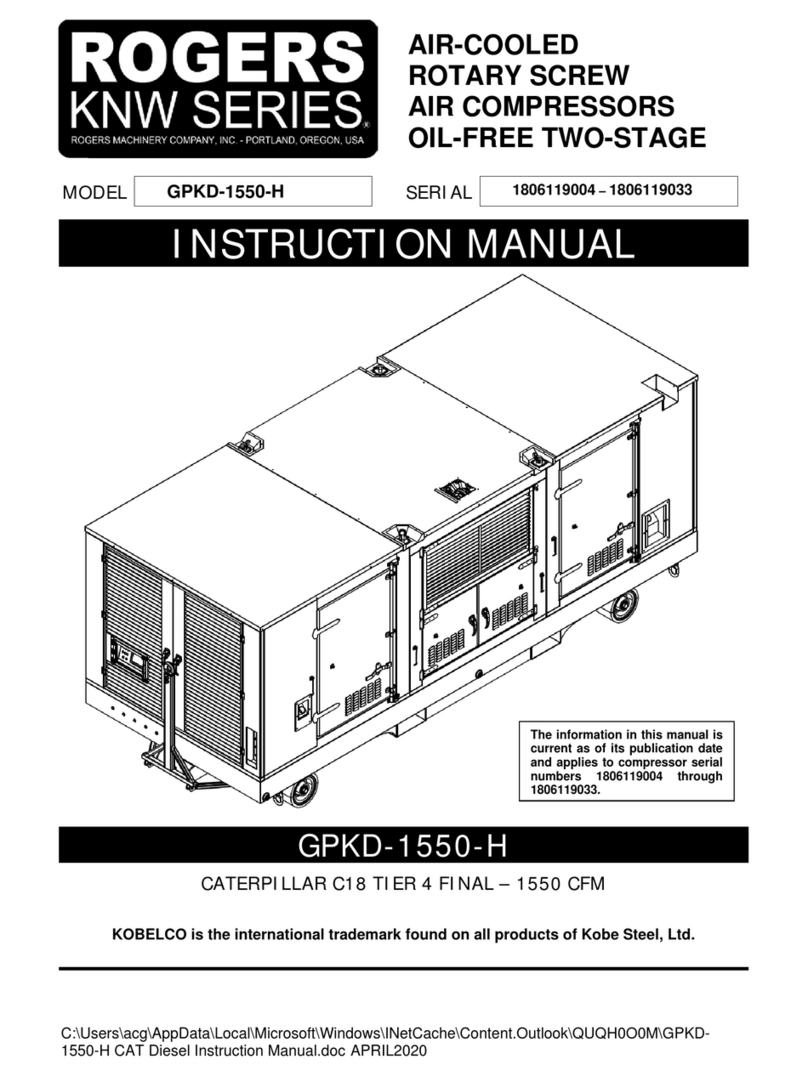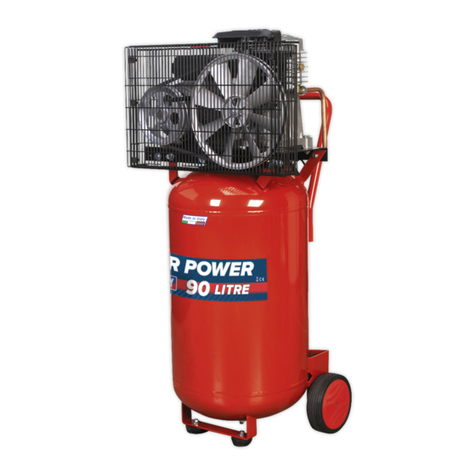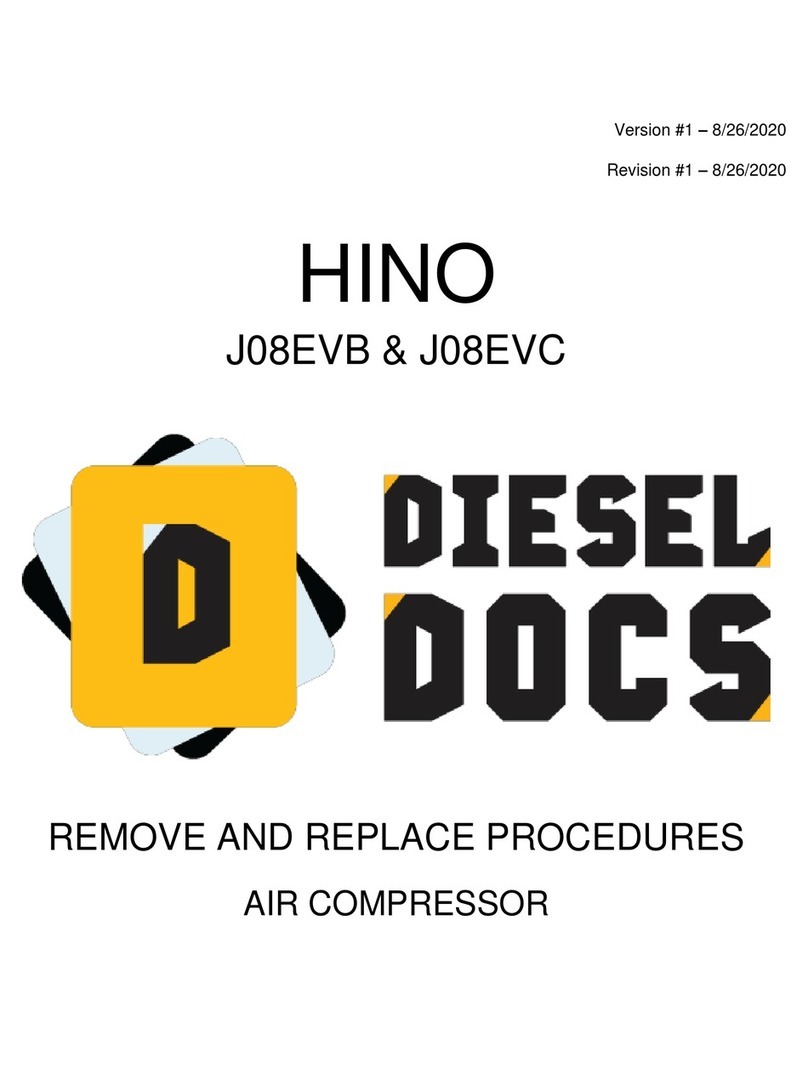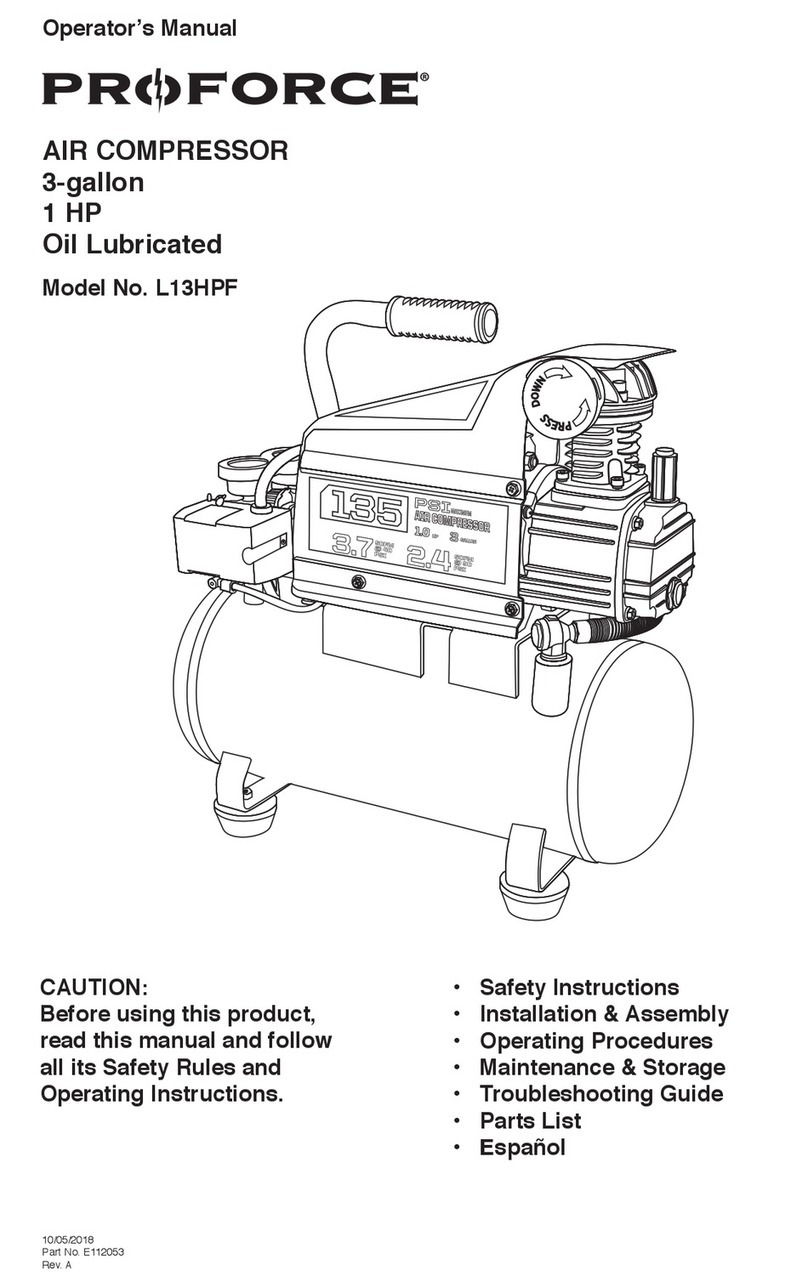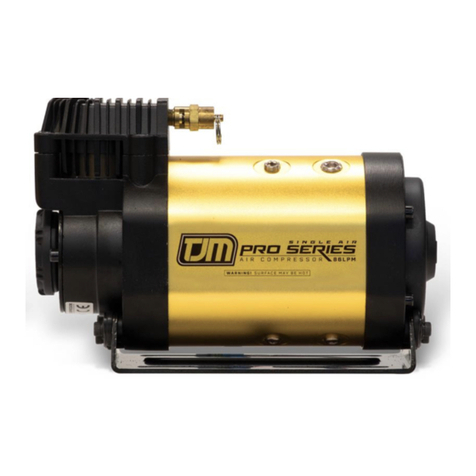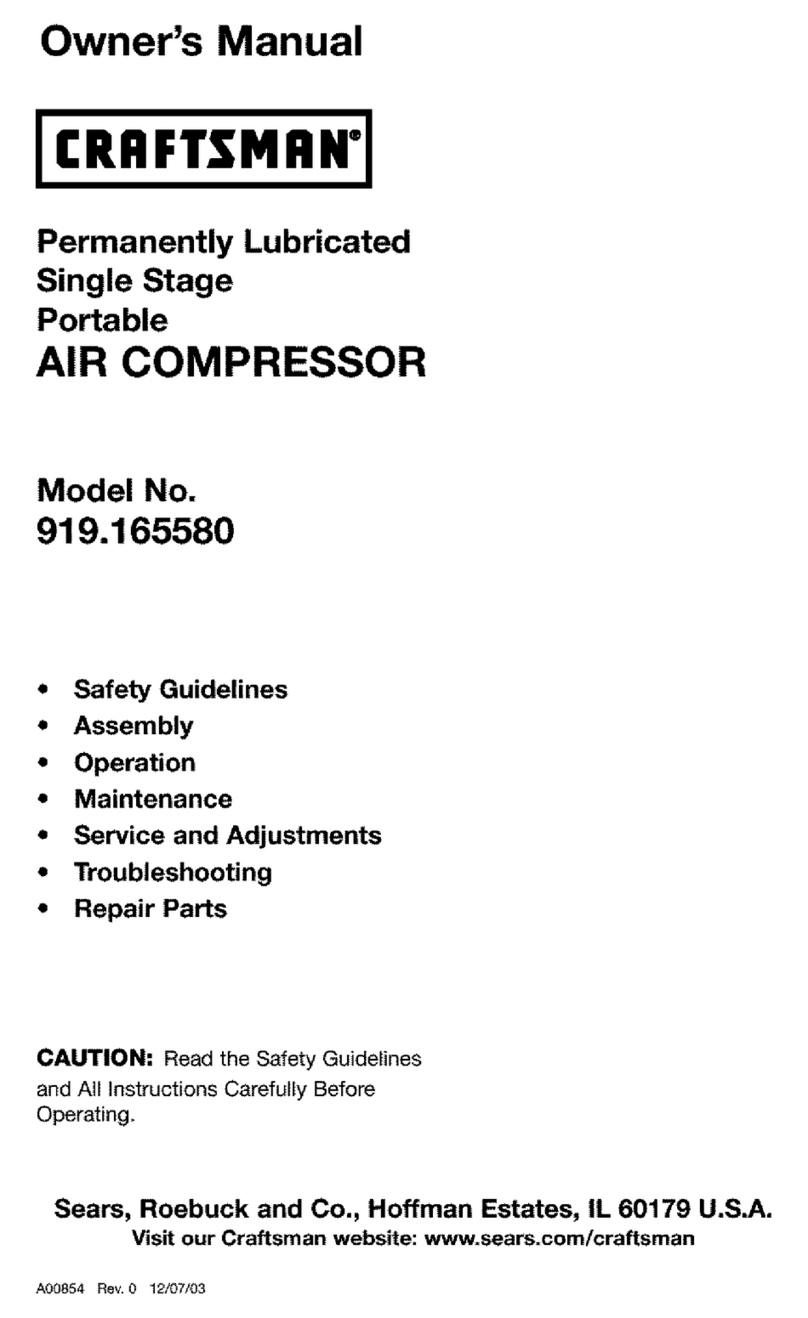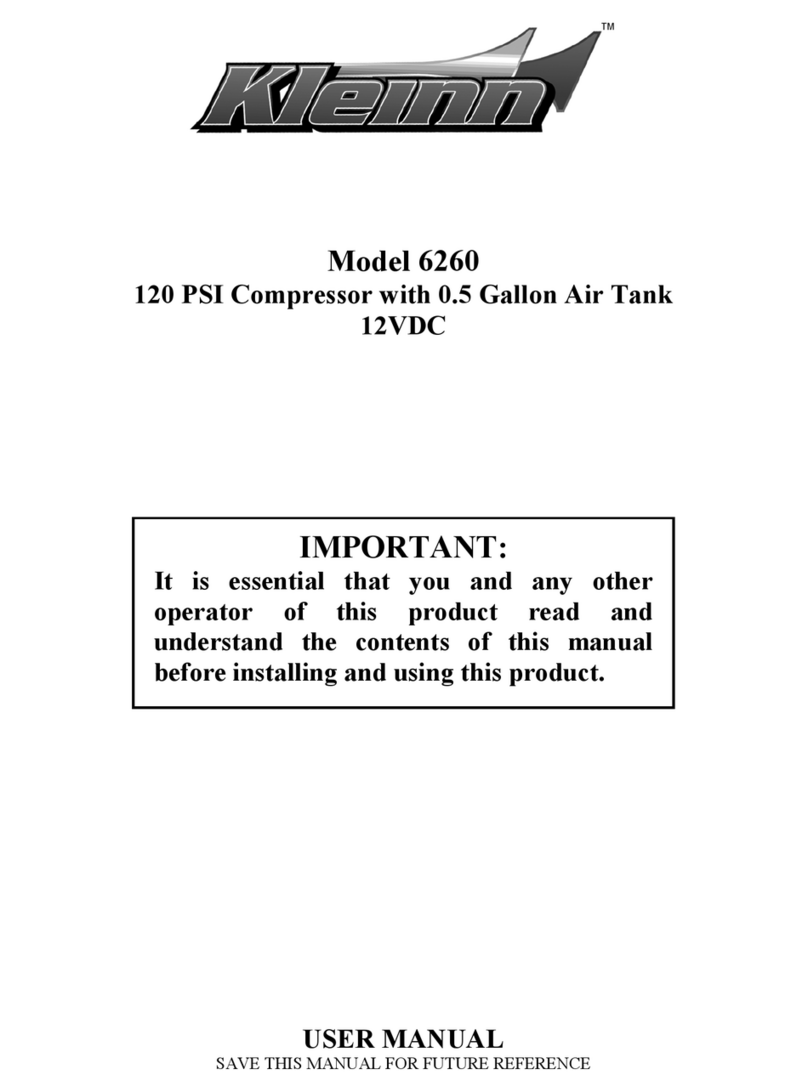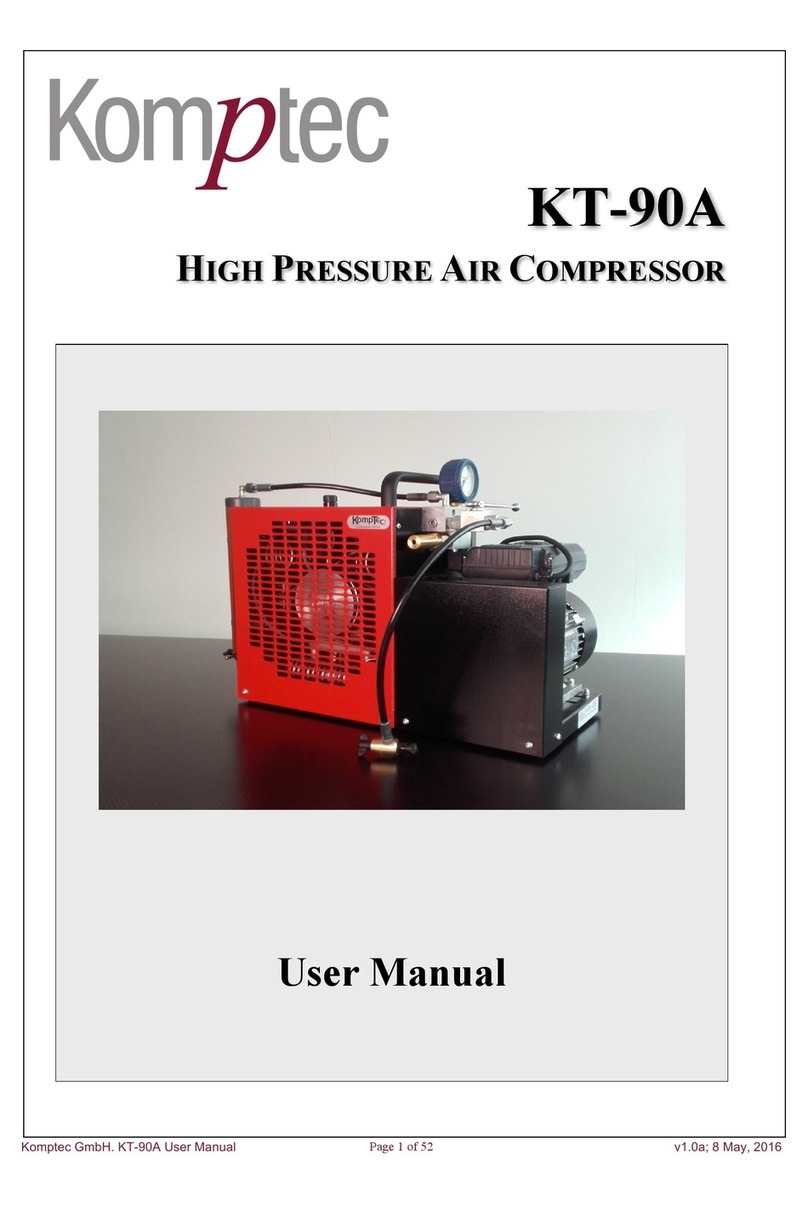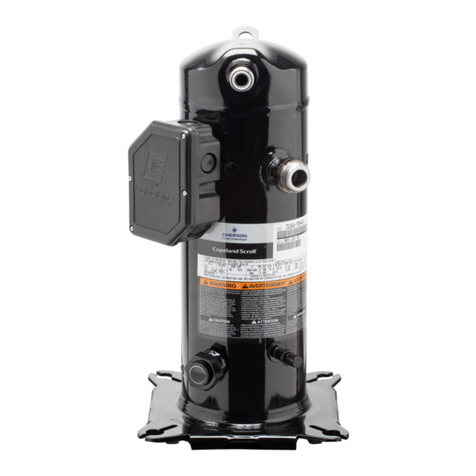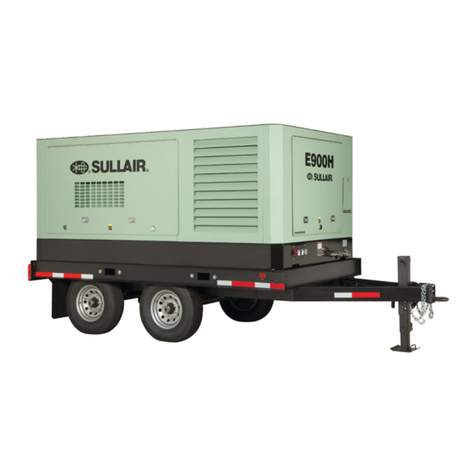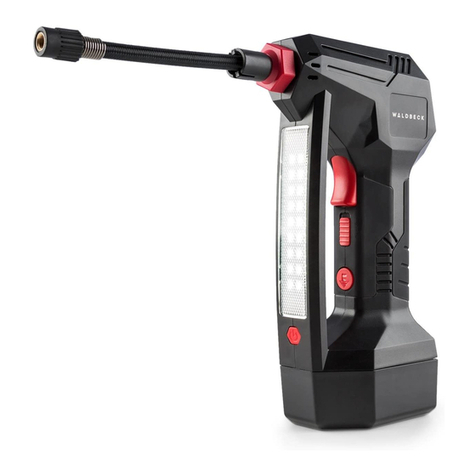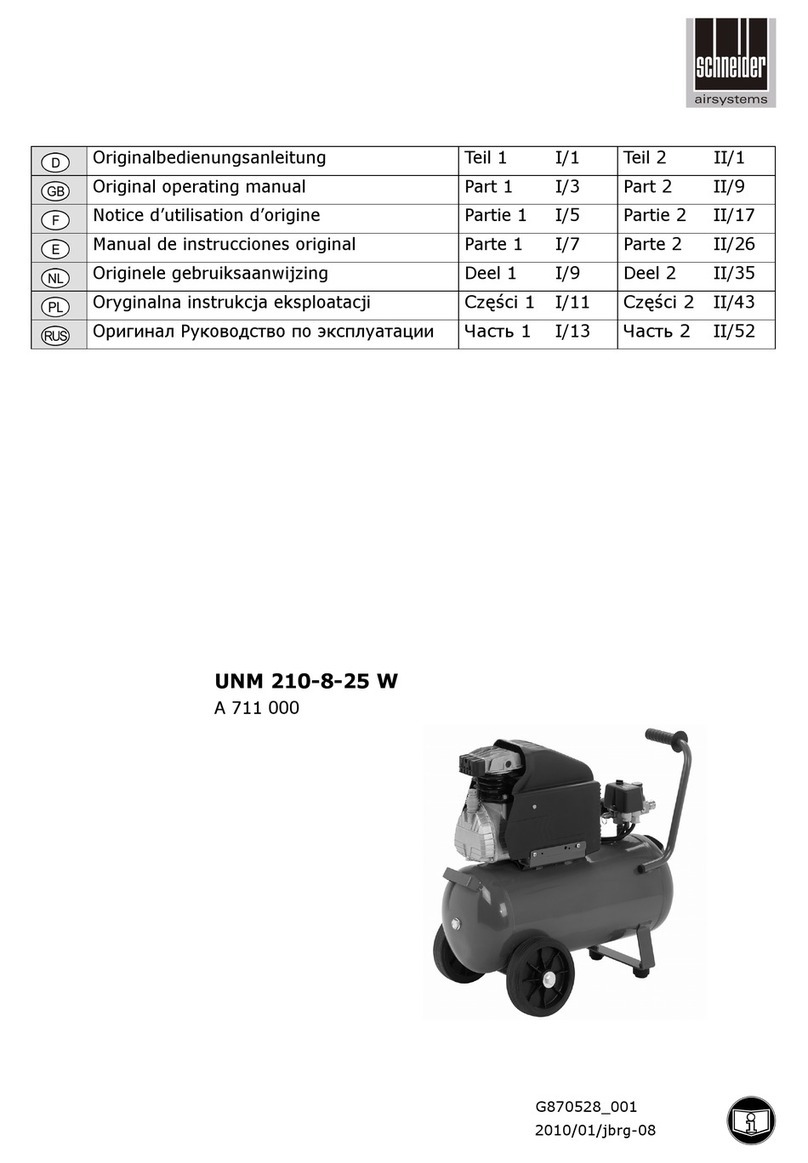Rogers KI Series User manual

1.
Model #: __________________ Serial #: __________________
®
Rotary Screw Air Compressors

1.
WARNING SUMMARY
Read and understand the contents of this manual and theOperation, Display and Controls Manuals for
your compressor before installing, operating, or maintaining the compressor. Failure to follow these
instructions may result in serious injury or death.
Electricity and compressed air are dangerous. Whenever performing maintenance or compressor service
work, ensure all electrical supply power is disconnected and mechanically locked out. Beware of multiple
power sources. Ensure all power sources are isolated before working on this equipment. Failure to follow
these instructions may result in serious injury or death.
The (customer furnished) discharge air line service valve must be closed, and the compressor relieved of
all internal pressure. DO NOT rely on the discharge air line check valve for isolation. Failure to follow
these instructions may result in serious injury or death.
Never use compressed air from this unit for breathing or food processing without adequate filtering and
monitoring to meet OSHA 29 CFR 1910 or FDA 21 CFR 178.3570. Failure to follow these instructions
may result in serious illness or death.
When operating, the compressor may have hot metal surfaces that could burn flesh on contact. Shut
down compressor and allow to cool before performing checks, services, and maintenance. Failure to
comply may cause serious injury or death.
When testing or operating the compressor, hearing and eye protection is required. Failure to comply can
cause hearing loss and serious eye damage or vision loss.
Do not allow flammable, toxic or corrosive gases to enter the air inlet system or electrical devices. Failure
to comply with this warning can result in personal injury or death and damage to equipment.
Never attempt to service or perform maintenance on your compressor, remove guards, panels, covers,
shields or other protective devices, while the compressor is in operation. Failure to comply with these
instructions may result in serious injury or death.
After each compressor servicing or maintenance, confirm that all safety and shutdown devices operate
properly. Failure to routinely test safety devices may result in serious injury or death.
Never override or bypass any safety or shutdown device installed on your compressor. Doing so can
result in personal injury or death and damage to equipment.
Make certain all associated piping and equipment installed beyond your compressor are compatible with
maximum pressures and temperatures to be encountered during operation of the compressor. Failure to
comply with these instructions may result in serious injury or death.
Never use plastic pipe in the compressed air system. Failure to comply with these instructions may result
in serious injury or death.
Keep doors closed during normal operation. The noise level inside cabinet may exceed 90 decibels (dBA)
and the operating temperature of some components is enough to burn skin on contact. Failure to follow
these instructions may result in serious injury.
i.

2.
WARNING SUMMARY – Continued.
Never assume it is safe to work on your compressor because it is not operating. Many systems have
automatic start/stop controls, which means the compressor may start at any time. Failure to comply with
these instructions may result in serious injury or death.
Facility personnel using the compressor equipment must thoroughly read, understand and comply with all
posted WARNING, CAUTION and DANGER placards placed on the K Series compressor system. This
equipment contains many possibilities for injury or death to personnel if care is not taken while working on
or near moving parts or electrical connections.
The following labels are used on the K Series compressor in conjunction with warnings used throughout
this manual, so that you do not miss important information. These labels are not meant to be a substitute
for reading the WARNING STATEMENT, but they give graphic descriptions of danger.
ii.

3.
PREFACE AND MANUAL OVERVIEW
Rogers KI and KIV Series rotary screw air compressors are designed for efficiency and longevity. Their
professional engineering, rugged design and quality construction will provide many years of trouble-free
operation if proper temperatures and lubrication are maintained.
The control panel provides visual indicators and audible alarms to inform you when attention is required
for proper care. Regular monitoring of these instruments will assist you with maintaining your preventive
maintenance program.
The KI/KIV Series electrical system communicates to the control panel providing ALERT and ALARM
signals. An ALERT notification indicates the compressor needs attention but has not shut down. For
example, a High Temperature Alert would indicate the compressor could be running hot and shut down is
imminent. Alerts are also used to notify you that service is required. A control panel ALARM indicates the
compressor has shut down and needs immediate attention. Refer to the CDP controller FAULT HISTORY
and the Description of Operation, Display and Controls Manual.
A list of replacement, service and repair parts are listed in the Parts List manual specific to the model of
your compressor. Contact your Rogers factory representative for more information.
The instructions contained in this manual cover compressor cleanliness of air and lubricant systems and
maintaining acceptable operating temperatures.
Detailed information regarding the compressor control panel is covered in the KI/KIV Description of
Operations / Display and Controls manual. Contact Rogers Machinery at 360-736-9356 for manual
information.
The warranty is a statement of value and confidence, and it is contingent upon proper maintenance and
attention
MODEL AND SERIAL NUMBERS
We recommend you take a moment to locate the Rogers Machinery ID Nameplate rivetted on every
compressor. Please write the MODEL and SERIAL numbers stamped on your compressor’s nameplate in
the space provided on the front cover of this manual. This way your compressor’s information will be at
hand if you need to speak with a Rogers Machinery representative.
The ID nameplate will look like this sample and will have your specific MODEL and SERIAL # stamped on
it.
iii.

4.
TABLE OF CONTENTS
CHAPTER 1 – GENERAL INFORMATION
1.0 GENERAL
1.1 Description ...................................................................................................... Page 1
1.2 Principles of Compressor Operation ............................................................. Page 1
1.3 Description of Air Flow .................................................................................. Page 2
1.4 Description of Lubricant and Cooling system ................................................ Page 5
1.4.1 Spin-On Filter Element ..................................................................... Page 5
1.4.2 Air-Cooled Coolers ........................................................................... Page 6
1.4.3 Temperature Regulating Valve ........................................................ Page 6
1.5 Description of Air and Lubricant Separator System ..................................... Page 7
1.5.1 Air/Lubricant Separator Reservoir ................................................... Page 7
1.5.2 Separator Element 10 and 20 HP ................................................... Page 7
1.5.3 Separator Element 25 to 100 HP .................................................... Page 7
1.6 Description of Standard Capacity Control System ....................................... Page 7
1.6.1 KI Series (10-50 HP) Load/Unload .................................................. Page 8
1.6.2 KIV Series (10-100 HP) VFD and Load/Unload................................ Page 8
1.6.3 Standby Delay Timer ....................................................................... Page 8
1.7 Maximum Operating Pressure with Standard Motor ..........................................Page 9
CHAPTER 2 – INSTALLATION INSTRUCTIONS
2.0 INSTALLATION
2.1 General ....................................................................................................... Page 11
2.2 Location ........................................................................................................Page 11
2.3 Foundation ................................................................................................... Page 11
2.4 Compressor Rotation ................................................................................. Page 11
V-Belt Drive System (10-50 HP) ............................................................................ Page 12
2.5.1 V-Belt Tension Adjustment ............................................................ Page 12
2.5.2 V-Belt Alignment ............................................................................ Page 13
2.5.3 V-Belt Inspection ........................................................................... Page 13
2.6 D-Face Mounted Drive System (60 to 100 HP) ......................................... Page 13
2.7 Cooling ....................................................................................................... Page 14
2.8 After Cooler ................................................................................................ Page 14
2.9 Optional Moisture Separator Drain ............................................................. Page 15
2.10 Package Discharge Service Valve ...............................................................Page 16
2.11 Air Piping .................................................................................................... Page 15
2.12 Air Receiver ................................................................................................ Page 16
CHAPTER 3 – ELECTRICAL INFORMATION
3.0 ELECTRICAL
3.1 Starter and Wiring ...................................................................................... Page 18
3.1.1 Voltage ............................................................................................. Page 18
3.1.2 Steps for Voltage Conversion ....................................................... Page 18
3.2 Motor Rotation ............................................................................................ Page 19
3.3 Blowdown Valve ......................................................................................... Page 19
3.4 Compressor Drive Motor ............................................................................ Page 19
3.4.1 General .......................................................................................... Page 20
3.4.2 Motor Bearing Lubrication ............................................................. Page 20
3.5 Local Display .............................................................................................. Page 20
3.6 Electrical Schematic ................................................................................... Page 20
iv.

5.
CHAPTER 4 – COMPRESSOR LUBRICATION
4.0 COMPRESSOR LUBRICANT
4.1 General ....................................................................................................... Page 22
4.2 Lubricant Service Intervals ......................................................................... Page 22
4.3 Lubricant Level Check ................................................................................ Page 22
4.4 Lubricant System / Cooling Data ................................................................ Page 23
4.5 Special maintenance of Compressor Lubricant System ............................ Page 23
4.5.1 Deposits ........................................................................................ Page 23
4.5.2 Long Term Storage ....................................................................... Page 24
4.5.3 Changing Lubricants ..................................................................... Page 24
4.5.4 Obtain Sample ............................................................................... Page 24
4.5.5 Lubricant Sample Kit ..................................................................... Page 24
4.6 Lubricant Filter ............................................................................................ Page 25
4.6.1 Lubricant Filter Change Intervals .................................................. Page 26
4.7 Separator Element Replacement ............................................................... Page 26
4.7.1 Spin-On Style, 10 – 20 HP ............................................................ Page 26
4.7.2 Top Hat Style, 25 – 100 HP .......................................................... Page 26
4.8 Lubricant Scavenging System .................................................................... Page 28
CHAPTER 5 – AIR INLET FILTER INFORMATION
5.0 AIR INLET FILTER
5.1 Air Inlet Filter Service ................................................................................. Page 32
CHAPTER 6 – COMPRESSOR OPERATIONS
6.0 OPERATIONS
6.1 Initial Start-up procedure ............................................................................ Page 36
6.2 Starting Unit (after initial start-up) .............................................................. Page 37
6.3 Stopping Unit (normal shut down) .............................................................. Page 37
6.4 Service intervals ......................................................................................... Page 38
6.4.1 Daily Checks-Unit Running at Operating Conditions .................... Page 38
6.4.2 When Required by Indicators or gauges ....................................... Page 38
6.4.3 Monthly .......................................................................................... Page 38
6.4.4 Every 1,000 Hours ......................................................................... Page 38
6.4.5 Every 3,000 Hours ......................................................................... Page 38
6.4.6 Every 6,000 Hours ......................................................................... Page 39
CHAPTER 7 – TROUBLESHOOTING
7.0 TROUBLESHOOTING GUIDE
7.1 Failure to Start ............................................................................... Page 42
7.2 Unscheduled Shutdown ................................................................ Page 42
7.3 Overload Relay Tripping ............................................................... Page 42
7.4 Excessive Lubricant Consumption ................................................ Page 43
7.5 Excessive Lubricant Carry – Over ................................................. Page 43
7.6 Frequent Air / Lubricant Separator Clogging ................................ Page 43
7.7 Low Reservoir Pressure / Low Air Delivery ................................... Page 44
7.8 High Discharge Pressure .............................................................. Page 44
7.9 High Discharge Air Temperature and/or High Lubricant Injection
Temperature .................................................................................. Page 44
7.10 Compressor Does Not Load .......................................................... Page 45
7.11 Excessive Cycling Between Load and Unload .............................. Page 45
7.12 Excessive Water in Plant Air Distribution System ......................... Page 45
7.13 Frequent Lubricant Filter Clogging ................................................ Page 45
7.14 Safety Valve Opens ....................................................................... Page 46
7.15 Vibration ........................................................................................ Page 46
v.

6.
7.16 Erratic Inlet Valve Operation ......................................................... Page 47
7.17 Frequent Inlet Air Filter Clogging (Alarms in 4,000 HRS Service... Page 47
7.18 Compressor Display Panel (CDP) Is Not On or Not Responding . Page 47
7.19 High Reservoir Pressure ............................................................... Page 47
CHAPTER 6 – FORMS, RECORDS AND ELECTRICAL SCHEMATICS
Important Shipping Bracket Information ................................................................... -
Rogers KI and KIV Record Card ............................................................................. -
KI and KIV Series Rotary Screw Air Compressor Start-Up Report ........................ -
Electrical Schematic – KI Series 10 HP: 208, 230, 460 VAC ................................... -
Electrical Schematic – KI Series 15 Through 50 HP: 208, 230, 460 VAC ................ -
Electrical Schematic – KI Series 60 Through 100 HP: 460 VAC .............................. -
Electrical Schematic – KIV Series 10 Through 100 HP: 460 VAC ............................ -
vi.

7.
INTENTIONALLY BLANK

8.
CHAPTER 1
GENERAL INFORMATION

1.
1.0 GENERAL
1.1 Description
The Rogers KI-Series air compressors are designed to deliver compressed air at an average volume
equal to demand by loading and unloading within a pressure range. Maximum pressure capability is
generally limited by compressor drive motor horsepower.
The Rogers KIV Series air compressors are virtually identical to the KI Series except the primary control
flow control is accomplished by motor speed control through a VFD (Variable Frequency Drive). The
compressor and motor speed up and slow down within a range to adjust its output to match demands. At
demands lower than the minimum speed compressor output, pressure will rise, and the compressor will
unload.
The basic compressor is a single-stage, positive displacement, lubricant injected twin screw unit. The
motor, compressor, associated equipment and components are mounted on a fabricated steel base within
a sound-attenuating enclosure. Air-cooled coolers dissipate heat of compression from the lubricant and
air using an independent cooling fan with motor. Controls and indicators pertaining to the compressor are
grouped on a common control panel. There are belt-driven units (10-50 HP) and direct-driven units (60-
100 HP) in the KI(V) Series.
Detailed discussion of the control systems is located in the Description of Operations / Display and
Controls manuals.
1.2 Principles of Compressor Operation
NOTE
The cycle of intake, compression, and discharge occurs five times during each 360-degree
rotation of the cambered rotor.
As shown in Figure 1, the compressor consists of two rotors within a casing. The male rotor (motor driven
rotor) is provided with five lobes and meshes with the female rotor which contains six grooves. Both rotors
are housed in a casing with two bores.
The casing is provided with an inlet port at the front (power input end of the compressor) and a discharge
port at the rear of the compressor opposite the compressor’s drive shaft. Both rotors are mounted on
single-row roller bearings at the inlet end and on tapered roller bearings at the discharge end. As the
rotors turn, air is drawn into the casing through the inlet port, trapping a fixed volume of air as the rotor
lobes move past the inlet port area.
This volume of air extends the entire length of the two rotors initially and is prevented from escaping by
the un-ported area of the cylinder rear wall. Oil is injected into the compression chamber during the
compression cycle as described in section 1.4.
As rotation continues, each lobe on the male rotor enters a groove in the female rotor, thus reducing the
volume of trapped air and resulting in continuous compression. Compression continues as the rotors
mesh together until the lobe and groove pair passes the discharge port.
At this point, the compressed air is released into the discharge line leading to the separator tank.
Note that the cycle of intake, compression, and discharge occurs five times during each 360 degree
rotation of the male rotor.

2.
Figure 1. KI and KIV Compressor Identification (Typical).
1.3 Description of Air Flow
This manual covers several different models. Figures 2 and 3 show a conceptual representation of
component layout within the compressor package and may not depict a component’s exact location.
With the motor running and compressor operating, under loaded conditions, low pressure (slight vacuum)
is achieved at the compressor inlet. Ambient air, entering via the compressor inlet air filter, flows through
the inlet valve into the screw compressor, is compressed and discharged into the separator tank. The air
discharged from the compressor contains lubricant which is removed as the air passes through the
lubricant separator in the separator tank.
The compressed air then passes through the discharge element, minimum pressure check valve and the
aftercooler into the system. A separately-mounted optional moisture separator and drain are available to
remove liquid condensate from the air after it leaves the compressor assembly. An air receiver with an
effective drain valve can also serve this purpose.
The quantity of air entering the compressor is regulated by the inlet valve located between the air filter
and the compressor casing’s inlet port. The position of the inlet valve is automatically controlled during
normal operation by system air pressure, as briefly described in Section 1.6 of this manual and in more
detail in the Description of Operations / Display and Controls manual.
For all KI and KIV compressors the air inlet valve serves as a check valve when the unit is shut down.
This prevents air and lubricant from flowing backwards in the inlet filter during shut down.
The separator tank is equipped with an ASME safety relief valve and high pressure shut down to protect
the equipment in the event of a malfunction in the capacity and pressure control system.
Air pressure in the separator tank is continuously indicated by a pressure gauge located on the tank and
digital readout on the Control Display Panel (CDP). Maximum operating pressure is limited by compressor
drive motor horsepower, the ASME safety relief valve setting, or electrical supply capability.

3.
Figure 2. KI/KIV 10 through 20 Horsepower Air Flow Diagram.
Table 1. KI/KIV 10 through 20 Horsepower Air Flow Components.
ITEM
NO.
DESCRIPTION
1
Oil Cooler
2
Oil Filter Head and Temperature Control Valve
3
Oil Filter Element
4
Intake Air Filter (Ambient Air)
5
Drive Shaft
6
Oil Drain Valve
7
ASME Safety Relief Valve
8
Oil Level Gauge (Not Shown)
9
Pressure Gauge
10
Separator Scavenging Tube
11
Minimum Pressure Check Valve
12
Spin-On Air Lubricant Separator Element
13
Inlet Check and Unloading Valve
14
Cooling Fan Motor
15
Discharge Air to Plant Systems
16
Air Cooler

4.
Figure 3. KI/KIV 25 through 100 Horsepower Air Flow Diagram.
Table 2. KI/KIV 25 through 100 Air Flow Components.
ITEM
NO.
DESCRIPTION
1
Oil Cooler
2
Oil Filter Head and Temperature Control Valve
3
Oil Filter Element
4
Intake Air Filter (Ambient Air)
5
Inlet Check and Unloading Valve
6
Drive Shaft
7
Oil Drain Valve
8
Oil Level Gauge (Not Shown)
9
ASME Safety Relief Valve
10
Oil Filler Port
11
Separator Scavenging Tube
12
Minimum Pressure Check Valve
13
Cooling Fan Motor
14
Discharge Air to Plant Systems
15
Air Cooler

5.
1.4 Description of Lubricant Flow and Cooling System
A diagram of the compressor lubricant system is shown in Figure 2 and 3. When the compressor
operates, lubricant from the reservoir of the separator tank is circulated through the lubricant cooler and
lubricant filter and injected into the compressor casing by differential pressure.
In the compressor housing, a lubricant gallery distributes lubricant to the front and rear rotor bearings of
both the male and female rotor and the compression chamber to seal the internal clearances, lubricate
the rotors and absorb most of the heat generated during compression of the air.
The lubricant and compressed air mixture is discharged from the compressor housing into the separator
tank via the discharge line or flanged connection.
1.4.1 Spin-On Filter Element
A spin-on type lubricant filter element is incorporated for ease of maintenance (Figure 4). All lubricant
passes through the lubricant filter before entering the compressor. This filter contains a quality, high-
efficiency filter element.
Figure 4. Typical Spin-on Oil Filter Location.

6.
1.4.2 Air-Cooled Coolers
The combination air-cooled lubricant cooler/aftercooler is comprised of two aluminum bar and plate
construction heat exchangers. A cooling fan blows cooling air across both coolers to reject heat from both
the compressor lubricant and the compressed air.
The fan is driven by an independent cooling fan motor.
1.4.3 Temperature Regulating Valve
The operating temperature of the machine is controlled by an automatic temperature regulating valve
which determines the proportion of lubricant that passes through the lubricant cooler versus bypassing
the cooler. The valve is integrated into the lubricant filter head which also includes the thermal control
element and bypass connection (see Figure 5). The function of the bypass is to maintain a minimum
temperature level to prevent excessive condensation from forming within the machine. The temperature
regulation is automatic and only adjustable by changing the thermal control element.
When the lubricant temperature is low, the lubricant enters the valve at port 1 (marked “IN”, from sump)
and flows partially to the cooler core via port 2 (marked “TC”, to cooler) and partially through an internal
bypass valve within the filter head. The oil from the cooler returns to the filter head via port 3 (marked
“FC” , from cooler) and mixes with lubricant from the internal bypass before flowing through the filter
element and to the air end via port 5 (marked “OUT”, to air end). See Figure 5.
As the compressor oil reaches operating temperature the bypass begins to close thus forcing more oil
through the lubricant cooler.
If the oil temperature is above the operating temperature the bypass will be fully closed and all the
compressor lubricant travels through the cooler directly.
In all cases the lubricant from the cooler and the bypass rejoin in the filter head before passing through
the spin-on oil filter. All oil is filtered before returning to the air end.
Figure 5. Typical Oil Filter Head and Temperature Control Valve Location.

7.
1.5 Description of Air and Lubricant Separator System
1.5.1 Air / Lubricant Separator Reservoir
The air / lubricant separator reservoir is an ASME coded pressure vessel which serves as a fluid reservoir
and provides mechanical separation of the lubricant and air. The air / lubricant reservoir should not be
welded on or modified in any way.
The discharge line from the compressor enters the reservoir above the lubricant level. A lubricant level
gauge is provided in the reservoir as a visual means to observe lubricant level during operation. An
ASME rated safety relief valve is located on the "wet" side before the lubricant separator element to
prevent the ASME rated separator tank from being over pressurized.
This is the “safety of last resort” and should not be used to control the air compressor. If this valve opens
to vent pressure, shut the compressor down and investigate the cause.
1.5.2 Separator Element, 10 and 15 HP
KI and KIV 10 through 20 HP units utilize an external spin-on separator element which is mounted
immediately downstream of the separator tank. Bulk lubricant separation occurs in the separator reservoir
mechanically and by gravity before coalescing filtration removes oil vapor from the air in the separator
element media. A scavenging tube returns separated lubricant to a low pressure area of the compressor.
See Figure 2.
1.5.3 Separator Element, 25 to 100 HP
KI and KIV 25 through 100 HP units are equipped with an internal separator element often referred to as
a “Top Hat” style separator system. The lubricant separator reservoir contains an air/lubricant separator
element beneath the tank’s lid. As air/lubricant mixture enters the reservoir, most of the lubricant
separates from the air and falls toward the bottom of the reservoir.
As the air passes through the lubricant separator element, lubricant coalesces on the separator element.
The lubricant which collects on the outside of the filter element drips into the bottom of the lubricant
reservoir. The lubricant that migrates to the inside of the separator element drains by gravity to the bottom
of the inside of the element where it is siphoned off via the scavenging return tube to a low pressure area
of the compressor. See Figure 3.
The minimum operating pressure on a standard machine is 80 PSIG. Operating below this pressure may
cause excessive carry-over of lubricant through the lubricant separator and high lubricant consumption
1.6 Description of Standard Capacity Control System
CAUTION
Care must be taken when working on or removing the inlet on a KI or KIV compressor to
prevent loose parts from being inadvertently dropped into the compressor inlet during
inspection and repair.
The KI and KIV series of air compressors (10 – 100 HP) use four (4) different inlet valves. Refer to the
Description of Operation, Display and Controls manual for detailed information about your compressor
capacity control system. The information in section 1.6 is general in nature.
The inlet valve is a combination modulating valve/check valve. Regardless of control pressure or valve
position, the valve fully closes on shutdown. This action limits back spinning and stops lubricant flow.

8.
Figure 6. Typical Inlet Valve.
1.6.1 KI Series Standard Control, (10 – 100 HP), Load Unload Operation
The standard operating mode of the KI 10-100 HP unit is load / unload. The load and unload set points
are set in the controller and are adjustable (see Description of Operations / Display and Controls manual).
The operation of the inlet valve is controlled by the internal springs and control air. When control air
pressure is present the actuator / inlet valve piston moves and closes the inlet valve (unloads
compressor). When the control air signal is removed, the inlet valve opens, and the compressor is loaded.
When the compressor is unloaded, the control solenoid is de-energized and the control air valve is open,
allowing control air to close the inlet valve.
When the compressor is loaded, the control solenoid is energized and the control air valve is closed,
bleeding off the control air allowing the inlet valve to open.
The KI-100 also has a differential pilot and has the ability to control the compressor with upper end
modulation before unloading. See Description of Operations / Display and Controls manual.
1.6.2 KIV Series (10-100 HP), VFD Control and Load / Unload
The standard operating mode of the KIV-10 through 100 HP units is VFD speed control. The compressor
has a target set pressure which adjusts the speed of the motor and thus the compressor outlet flow.
The controller also has LOAD and UNLOAD PRESSURE SET POINTS which will unload the compressor
typically when the unit is at minimum speed. See Description of Operations / Display and Controls manual
for additional details.
1.6.3 Standby Delay

9.
All KI and KIV units have a standby delay timer which will shut the compressor off if it has been operating
unloaded for a set period of time. The unload timer is adjustable. See Description of Operations / Display
and Controls manual to set this timer.
1.7 Maximum Operating Pressure with Standard Motor
CAUTION
DO NOT exceed motor nameplate Service Factor amps at 100% capacity. Failure to follow
this caution may result in damage to the drive motor.
Maximum operating pressure is limited by available motor power and the safety valve setting. Because of
the many available air end, sheave and motor combinations it is not practical to define all combinations.
When resetting operating pressures adjust pressure upward while observing an ammeter reading on all
phases compared to motor nameplate limits. See Table 3.
Table 3. Maximum Operating Pressure with Standard Motor.
MODEL
STANDARD
MOTOR HP
MAXIMUM PRESSURE
(PSIG)
KI/KIV-10-100
10
110
KI/KIV-10-125
10
135
KI/KIV-10-150
10
160
KI/KIV-15-100
15
110
KI/KIV-15-125
15
135
KI/KIV-15-150
15
160
KI/KIV-20-100
20
110
KI/KIV-20-125
20
135
KI/KIV-20-150
20
160
KI/KIV-25-100
25
110
KI/KIV-25-125
25
135
KI/KIV-25-150
25
160
KI/KIV-30-100
30
110
KI/KIV-30-125
30
135
KI/KIV-30-150
30
160
KI/KIV-40-100
40
110
KI/KIV-40-125
40
135
KI/KIV-40-150
40
160
KI/KIV-50-100
50
110
KI/KIV-50-125
50
135
KI/KIV-50-150
50
160
KI/KIV-60-100
60
110
KI/KIV-60-125
60
135
KI/KIV-75-100
75
110
KI/KIV-75-125
75
135
KI/KIV-100-100
100
110
KI/KIV-100-125
100
135

10.
CHAPTER 2
INSTALLATION INSTRUCTIONS

11.
2.0 INSTALLATION
2.1 General
On receipt of unit, check for any damage received in transit. If damage or missing parts are noted, report
immediately to the delivering carrier. Care should be exercised when transporting the compressor to
avoid damage to the components.
Check the compressor and motor base for support brackets which are painted red (see Chapter 6). These
brackets should be removed after installation. Their purpose is solely to prevent damage during transport.
NOTE
KI(V)-10 units do not have these shipping brackets.
2.2 Location
The unit should be installed in a clean, well ventilated area with adequate service clearance on all sides
of the machine. (Refer to the compressor assembly drawing) Select a location that will provide a clean,
cool, dry source of air for the inlet and compressor ventilation.
It may be necessary to install an outside source of clean air to the machine for cooling and for the inlet
air. The motor must not operate at full load for prolonged periods in ambient temperatures greater than
104 °F (40 °C). If ambient temperatures falls below 36 °F (2 °C), consult your Rogers factory
representative for recommendations on how to protect the machine from cold conditions.
Air-cooled units require large quantities of cooling air to remove the heat from compression. Obstruction
of the cooling air inlet and outlet areas of the compressor cabinet will negatively affect the reliability and
performance of the compressor.
Ideally the cooling air is ducted directly outside the compressor room rather than having the cooling air
discharged into the compressor room. Dilution cooling requires much higher volumes of cooling air to be
ventilated out of the compressor room.
2.3 Foundation
The air compressor unit does not require a heavy foundation. However, to maintain drive alignment and
prevent potentially damaging vibrations, the unit must be evenly supported. Mounting bolts, if used, must
be carefully secured such that the compressor base is not distorted. Do not weld on compressor unit or
base as damage to the bearings and or controls can occur. Do not use the wooden shipping pallet as a
permanent base.
2.4 Compressor Rotation
Rotary screw compressors require rotation in the correct direction to prevent damage to the bearings and
rotor clearances. It is critical that the rotation be established correctly during start up procedures and any
time that the motor leads or supply power phasing may have been changed. Examples include during
component replacement such as a motor, contactor or power supply components. Table 8 below states
the correct rotation for each model. The compressor casings are marked for correct rotation. It can be
noted that correct rotation will have the rotors separating from each other at the inlet.
This manual suits for next models
53
Table of contents
Other Rogers Air Compressor manuals
